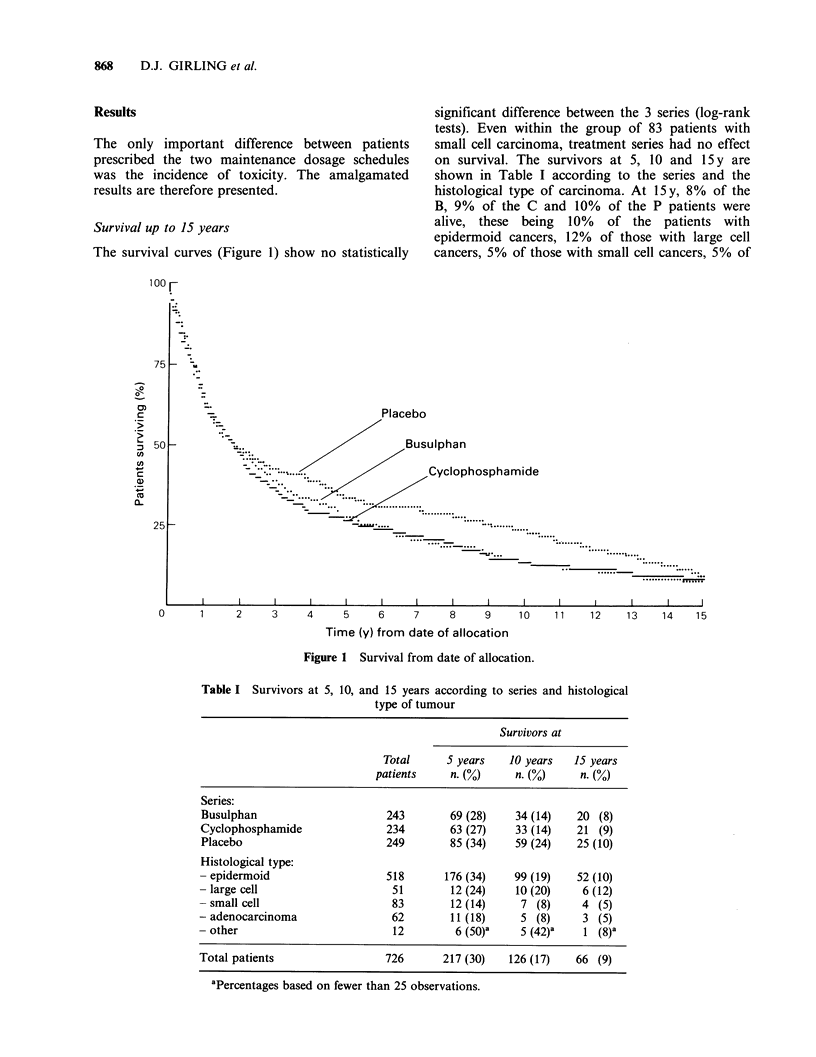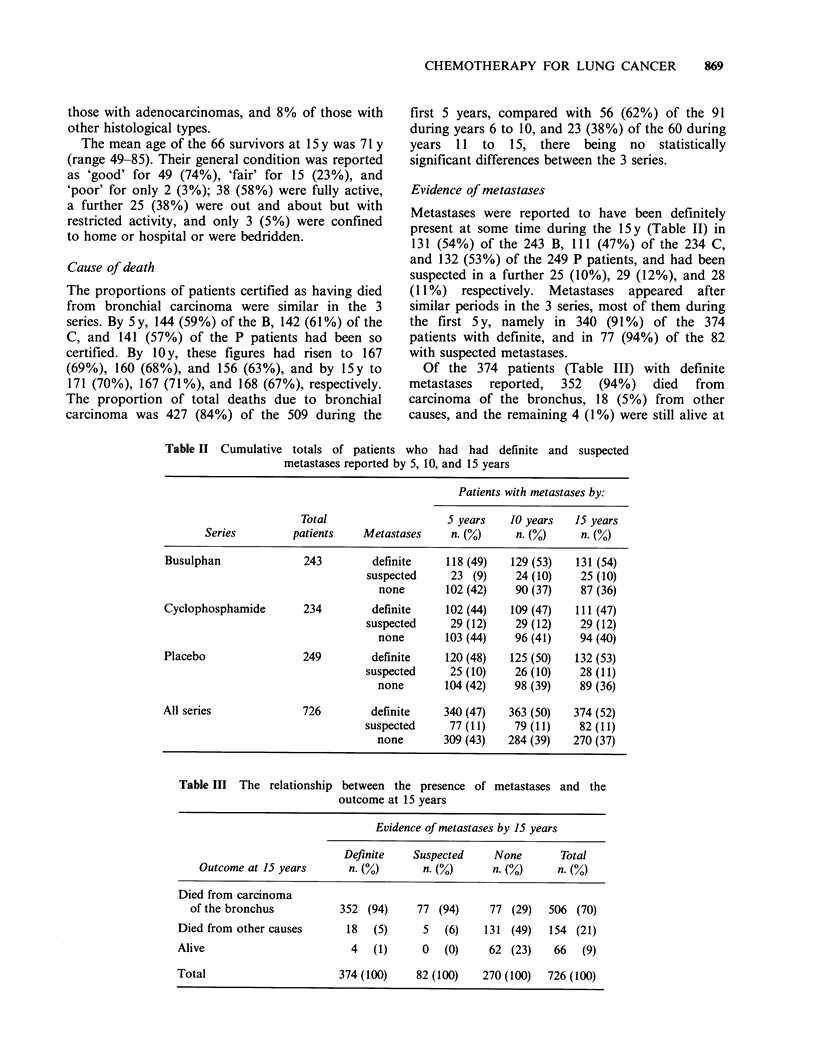Abstract
The 15-year findings are presented of a double-blind, randomised study planned in 1964 in which cytotoxic chemotherapy with either busulphan or cyclophosphamide prescribed to be given daily for 2 years as an adjuvant to surgery was compared with placebo in the treatment of 726 patients with carcinoma of the bronchus. The two cytotoxic agents administered in this way did not influence survival. At 15y, 8% of the 243 patients allocated busulphan, 9% of the 234 cyclophosphamide, and 10% of the 249 placebo were alive, these being 10% of the patients who had had epidermoid cancers, 12% large-cell, 5% small-cell, 5% adenocarcinomas, and 8% other histological types. The study provides data on long-term results in a large group of patients who were, in effect, treated by surgery alone. Survival was significantly shorter in patients with histological involvement of the resected intrathoracic nodes (log-rank test P much less than 0.001). A finding of particular interest is that the histological type of the tumour did not influence survival in the 390 patients whose nodes were not involved, although, as expected, it did in the 336 whose nodes were involved, the 226 with epidermoid cancers surviving longer than the 57 with small cell carcinoma, the 31 with adenocarcinoma and all 110 with non-epidermoid carcinomas (P much less than 0.001 in each comparison).
Full text
PDF






Selected References
These references are in PubMed. This may not be the complete list of references from this article.
- Alberto P. Remission rates, survival, and prognostic factors in combination chemotherapy for bronchogenic carcinoma. Cancer Chemother Rep 3. 1973 Mar;4(2):199–206. [PubMed] [Google Scholar]
- BELCHER J. R., ANDERSON R. SURGICAL TREATMENT OF CARCINOMA OF THE BRONCHUS. Br Med J. 1965 Apr 10;1(5440):948–954. doi: 10.1136/bmj.1.5440.948. [DOI] [PMC free article] [PubMed] [Google Scholar]
- Bergsagel D. E. An assessment of massive-dose chemotherapy of malignant disease. Can Med Assoc J. 1971 Jan 9;104(1):31–36. [PMC free article] [PubMed] [Google Scholar]
- Bignall J. R., Martin M., Smithers D. W. Survival in 6086 cases of bronchial carcinoma. Lancet. 1967 May 20;1(7499):1067–1070. doi: 10.1016/s0140-6736(67)92647-5. [DOI] [PubMed] [Google Scholar]
- Bunn P. A., Jr, Cohen M. H., Ihde D. C., Fossieck B. E., Jr, Matthews M. J., Minna J. D. Advances in small cell bronchogenic carcinoma. Cancer Treat Rep. 1977 May-Jun;61(3):333–342. [PubMed] [Google Scholar]
- Clee M. D., Hockings N. F., Johnston R. N. Bronchial carcinoma: factors influencing postoperative survival. Br J Dis Chest. 1984 Jul;78(3):225–235. [PubMed] [Google Scholar]
- DENK W., KARRER K. Combined surgery and chemotherapy in the treatment of malignant tumors. Cancer. 1961 Nov-Dec;14:1197–1204. doi: 10.1002/1097-0142(196111/12)14:6<1197::aid-cncr2820140609>3.0.co;2-1. [DOI] [PubMed] [Google Scholar]
- Green R. A., Humphrey E., Close H., Patno M. E. Alkylating agents in bronchogenic carcinoma. Am J Med. 1969 Apr;46(4):516–525. doi: 10.1016/0002-9343(69)90071-0. [DOI] [PubMed] [Google Scholar]
- Higgins G. A., Beebe G. W. Bronchogenic carcinoma. Factors in survival. Arch Surg. 1967 Apr;94(4):539–549. doi: 10.1001/archsurg.1967.01330100103016. [DOI] [PubMed] [Google Scholar]
- Higgins G. A., Jr Use of chemotherapy as an adjuvant to surgery for bronchogenic carcinoma. Cancer. 1972 Nov;30(5):1383–1387. doi: 10.1002/1097-0142(197211)30:5<1383::aid-cncr2820300536>3.0.co;2-o. [DOI] [PubMed] [Google Scholar]
- Higgins G. A., Lawton R., Heilbrunn A., Keehn R. J. Prognostic factors in lung cancer. Surgical aspects. Ann Thorac Surg. 1969 May;7(5):472–480. doi: 10.1016/s0003-4975(10)66211-x. [DOI] [PubMed] [Google Scholar]
- Higgins G. A., Shields T. W., Keehn R. J. The solitary pulmonary nodule. Ten-year follow-up of veterans administration-armed forces cooperative study. Arch Surg. 1975 May;110(5):570–575. doi: 10.1001/archsurg.1975.01360110116019. [DOI] [PubMed] [Google Scholar]
- Karrar K. Importance of dose schedules in adjuvant chemotherapy. Cancer Chemother Rep. 1972 Feb;56(1):35–45. [PubMed] [Google Scholar]
- Kron I. L., Harman P. K., Mills S. E., Walker A. N., Cooper P. H., Minor G. R., Nolan S. P. A reappraisal of limited-stage undifferentiated carcinoma of the lung. Does stage I small cell undifferentiated carcinoma exist? J Thorac Cardiovasc Surg. 1982 Nov;84(5):734–737. [PubMed] [Google Scholar]
- POULSEN O. Cyclophosphamide. An evaluation of its cytostatic effects on surgically treated carcinoma of the lung. J Int Coll Surg. 1962 Feb;37:177–187. [PubMed] [Google Scholar]
- Pool J. L. Survival in lung cancer; effectiveness of surgery. N Y State J Med. 1971 Sep 1;71(17):2045–2049. [PubMed] [Google Scholar]
- SULLIVAN R. D. Myleran therapy in bronchogenic carcinoma. Ann N Y Acad Sci. 1958 Apr 24;68(3):1038–1045. doi: 10.1111/j.1749-6632.1958.tb42662.x. [DOI] [PubMed] [Google Scholar]
- Selawry O. S. The role of chemotherapy in the treatment of lung cancer. Semin Oncol. 1974 Sep;1(3):259–272. [PubMed] [Google Scholar]
- Spiro S., Goldstraw P. The staging of lung cancer. Thorax. 1984 Jun;39(6):401–407. doi: 10.1136/thx.39.6.401. [DOI] [PMC free article] [PubMed] [Google Scholar]
- Stott H., Fox W., Girling D. J., Stephens R. J., Galton D. A. Acute leukaemia after busulphan. Br Med J. 1977 Dec 10;2(6101):1513–1517. doi: 10.1136/bmj.2.6101.1513. [DOI] [PMC free article] [PubMed] [Google Scholar]
- Stott H., Stephens R. J., Fox W., Roy D. C. 5-year follow-up of cytotoxic chemotherapy as an adjuvant to surgery in carcinoma of the bronchus. Br J Cancer. 1976 Aug;34(2):167–173. doi: 10.1038/bjc.1976.139. [DOI] [PMC free article] [PubMed] [Google Scholar]


